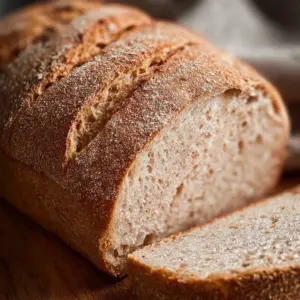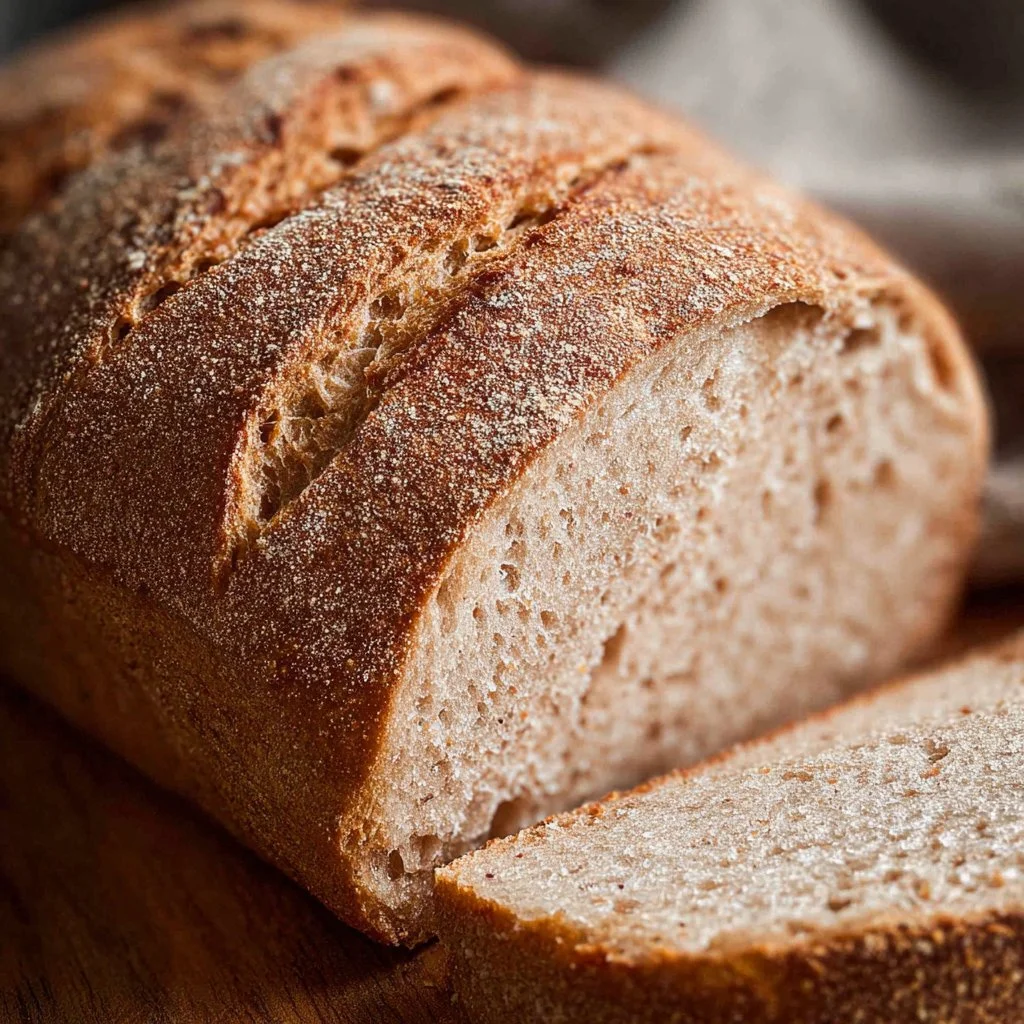Gluten Free Sourdough Bread offers a delightful alternative for those who have gluten sensitivities or celiac disease. Sourdough bread has a unique tangy flavor and chewy texture, and making it gluten-free allows everyone to indulge in this classic staple without worry. Whether you are a seasoned baker or new to gluten-free cooking, this guide will walk you through the process of creating your own gluten-free sourdough bread from scratch.
Why We Love This Gluten Free Sourdough Bread Recipe
What makes this gluten-free sourdough bread stand out is its incredible flavor and texture. You receive the benefits of traditional sourdough with the reassurance of gluten-free ingredients. The combination of brown rice flour, tapioca flour, and psyllium husks provides a hearty structure that mimics the characteristics of gluten. Further, incorporating a sourdough starter imparts that necessary tang, elevating the eating experience.
This bread is not just for those with dietary restrictions. It’s a fantastic option for anyone looking to explore the world of gluten-free baking. In addition, it is perfect for sandwiches, toast, or simply slathered with butter.
Furthermore, it’s not just about taste. The nutritional profile of this gluten-free sourdough bread is impressive, packed with nutrients from the whole foods you are putting into it. So, put on your apron and let’s dive into the world of gluten-free sourdough baking!
Ingredients about Gluten Free Sourdough Bread
To create a lovely loaf of gluten-free sourdough bread, gather these ingredients:
- 1/2 cup (125 g) unfed gluten-free sourdough starter
- 1/2 cup (70 g) brown rice flour
- 1/4 cup (60 g) water
- 1 1/2 cups + 2 tablespoons (390 g) water
- 2 tablespoons (10 g) ground flax seed
- 1 cup (250 g) gluten-free sourdough starter
- 1 tablespoon (20 g) honey (or agave)
- 1/4 cup (60 g) olive oil
- 1 teaspoon (5 g) apple cider vinegar
- 1 1/2 cups (210 g) brown rice flour
- 1 cup (120 g) tapioca flour
- 1/2 cup (60 g) corn starch
- 2 tablespoons (16 g) psyllium husks
- 2 1/2 teaspoons (8 g) xanthan gum
- 2 teaspoons (10 g) salt
- 1 tablespoon baking powder
How to Make Gluten Free Sourdough Bread Directions
Creating your own gluten-free sourdough bread is simple and rewarding. Follow these detailed steps for your baking journey:
Begin by feeding your starter 12 hours before you start mixing. This involves combining the unfed starter with brown rice flour and water in a clean jar. Cover it and let it rise at room temperature until it’s bubbly and active. This starter will be the foundation of your bread’s unique flavor.
In a separate bowl, mix the wet ingredients. Combine water, honey (or agave), olive oil, and apple cider vinegar. If you prefer a slight sweetness, honey adds a lovely touch.
In another bowl, combine the dry ingredients. You can use a stand mixer on low speed. Mix the brown rice flour, tapioca flour, corn starch, psyllium husks, xanthan gum, salt, and baking powder for about 1-2 minutes. The goal here is to ensure everything is evenly distributed.
Once your wet ingredients are combined, pour them into the bowl of dry ingredients. Mix everything on low speed for approximately 5 minutes. This process helps to develop the structure of the bread without the gluten.
The next step is to prepare your baking tin. Line a 9″ x 5″ baking pan with parchment paper for easy removal later. Pour the dough into the tin, ensuring it is spread evenly. The dough will be thick, so a spatula can help you smooth it out.
Place the dough in a warm area and let it rise. The rising time can vary between 3 to 12 hours, depending on the temperature of your environment. You’ll know it’s ready when it rises above the edge of the tin.
Preheat your oven to 375°F (190°C). Just before baking, score the top of the dough using a sharp knife or bread lame. This scoring allows steam to escape during baking, resulting in a better crust.
Bake your gluten-free sourdough bread for 60 minutes. The aroma will fill your kitchen, making it hard to resist.
Once baked, remove the bread from the tin and let it cool on a wire rack. Cooling prevents excess moisture from making your bread soggy. Wait for it to cool completely before slicing, as this allows for better texture.
How to Serve Gluten Free Sourdough Bread
The beauty of gluten-free sourdough bread lies not only in its creation but also in the many ways you can serve it. Freshly baked and cooled, this bread can be enjoyed in various forms.
For breakfast, toast a slice and spread it with your favorite jam or nut butter. The crunchy exterior pairs perfectly with the creamy toppings. You could also enjoy it with a sprinkle of cinnamon and sugar for a sweet morning treat.
For lunches, consider using gluten-free sourdough bread as the base for a hearty sandwich. Load it up with your choice of fresh vegetables, spreads, and proteins such as turkey, cheese, or hummus. The chewy texture adds a satisfying bite to your meal.
At dinner, serve slices alongside soups or salads. Its robust nature complements hearty dishes, providing a good balance. You can even turn it into croutons for a delightful salad crunch by cubing it, tossing with olive oil, and lightly roasting it in the oven.
Expert Tips: Gluten Free Sourdough Bread
Creating gluten-free sourdough bread can be simple, yet a few expert tips can enhance your results and make the process smoother:
Starter Care: Always ensure your sourdough starter is active and bubbly before using it in the recipe. This is crucial as a healthy starter contributes to better flavor and texture.
Consistent Temperature: During the rising stage, a warm spot helps the dough to rise properly. If your kitchen is cold, consider placing it in an oven preheated to the lowest setting, then turned off.
Hydration Level: Gluten-free dough tends to be thicker than traditional dough. If your mixture seems too dry, slowly add a tablespoon of water at a time; conversely, if it’s too wet, add some brown rice flour until you achieve your desired consistency.
Storage: Keep your sourdough bread in an airtight container at room temperature for up to three days, or freeze it for longer storage. Slicing the bread before freezing can make future servings quick and convenient.
Experiment with Flavors: Don’t hesitate to experiment by adding herbs, spices, or seeds into the dough for added flavor and texture. Ingredients like rosemary, thyme, or chia seeds can elevate your gluten-free sourdough bread.
How to Store Gluten Free Sourdough Bread
Proper storage is key to maintaining the freshness of your gluten-free sourdough bread. Here are some tips to ensure it stays delicious:
Room Temperature: Your gluten-free sourdough bread can be stored at room temperature in an airtight container or bag for up to three days. This is ideal for daily consumption.
Refrigeration: While refrigeration can prolong the shelf life of traditional bread, it usually dries out gluten-free bread faster. Avoid it if possible.
Freezing: For longer storage, slice the bread and wrap it tightly in plastic wrap or foil before placing it in a resealable freezer bag. It can be frozen for up to three months. To enjoy, simply take out a slice and toast it directly from the freezer.
Variation of Gluten Free Sourdough Bread
This sourdough recipe offers a strong foundation for creativity. By trying some variations, you can tailor the bread to suit your taste:
Herb-Infused Sourdough: Incorporate dried herbs like rosemary, thyme, or oregano into the dry ingredients. This will infuse the bread with a delightful aroma and flavor.
Seeded Sourdough: Add a mixture of seeds such as sunflower seeds, pumpkin seeds, or sesame seeds to the dough to enhance texture as well as nutritional value.
Sweet Variations: Create a sweeter version by adding a handful of dried fruit like raisins or cranberries, along with spices such as cinnamon or nutmeg.
Nutty Sourdough: For a nutty flavor, consider mixing in finely chopped nuts like walnuts or almonds into the bread mixture.
Experimenting with different variations can be a fun way to make each baking experience unique.
FAQ
What is Gluten Free Sourdough Bread?
Gluten-free sourdough bread is a variation of traditional sourdough bread made without gluten-containing ingredients. Instead, gluten-free flours such as brown rice flour, tapioca flour, and corn starch are used to create a delicious and chewy texture similar to regular sourdough.
Can I use a store-bought gluten-free sourdough starter?
Yes, you can use a store-bought gluten-free sourdough starter. Just ensure it is active and bubbly before using it in your recipe. This will help in achieving the required fermentation and sour flavor.
How long does gluten-free sourdough bread last?
Homemade gluten-free sourdough bread can stay fresh at room temperature for up to three days. If you’d like to keep it longer, slice it and store it in the freezer, where it can last for up to three months.
What ingredients can I substitute in gluten-free sourdough bread?
You can substitute brown rice flour with other gluten-free flours, though it may affect the texture and flavor. Tapioca flour and corn starch also play vital roles in this recipe; avoid altering these unless you’re sure of the alternatives.
Why is my gluten-free sourdough bread dense?
A dense loaf could result from various factors, such as not enough rising time, not using an active starter, or incorrect flour ratios. Pay attention to the hydration level and allow the dough ample time to rise for a light, airy loaf.

Gluten Free Sourdough Bread
Equipment
- Mixing Bowls:
- 9×5 inch baking pan
- Stand Mixer
Ingredients
- 1/2 cup unfed gluten-free sourdough starter
- 1/2 cup brown rice flour
- 1/4 cup water
- 1 1/2 cups water plus 2 tablespoons
- 2 Tbsp ground flax seed
- 1 cup gluten-free sourdough starter
- 1 Tbsp honey or agave
- 1/4 cup olive oil
- 1 tsp apple cider vinegar
- 1 1/2 cups brown rice flour
- 1 cup tapioca flour
- 1/2 cup corn starch
- 2 Tbsp psyllium husks
- 2 1/2 tsp xanthan gum
- 2 tsp salt
- 1 Tbsp baking powder
Instructions
- Feed your starter 12 hours before starting by mixing unfed starter with brown rice flour and water. Let it rise until bubbly.
- In a bowl, mix wet ingredients: water, honey, olive oil, and apple cider vinegar.
- In another bowl, combine dry ingredients: brown rice flour, tapioca flour, corn starch, psyllium husks, xanthan gum, salt, and baking powder.
- Pour wet ingredients into dry ingredients. Mix on low speed for about 5 minutes.
- Prepare a 9×5 inch baking pan by lining it with parchment paper. Pour the dough into the pan and spread evenly.
- Let the dough rise in a warm area for 3 to 12 hours until it rises above the edge of the tin.
- Preheat oven to 375°F (190°C). Score the top of the dough before baking.
- Bake for 60 minutes. Remove from the tin and cool on a wire rack before slicing.
Send me this recipe!
Just enter your email below and get it sent straight to your inbox!



